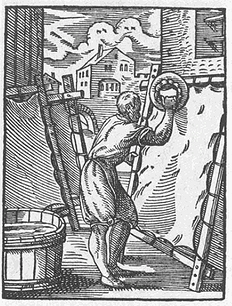Two years ago, Michael Drout over at his Wormtalk and Slugspeak blog got all excited with the idea to extract DNA from old parchment. Nicknamed the “Crazy Sheep DNA Guy” at this time, his dream has now come true, at least to a certain extent.
 Parchment is made of animal skin, mostly from goat and sheep, which has been dried and scraped under tension. It was the preferred writing support material for manuscripts and maps from around 200 BC until the 16th century, when it was replaced by paper. In the late Middle Ages, town parchment makers (“parchmenters”) had shops in the vicinity of artisans and trade groups. The picture to the left shows a German parchmenter around 1568 [1].
Parchment is made of animal skin, mostly from goat and sheep, which has been dried and scraped under tension. It was the preferred writing support material for manuscripts and maps from around 200 BC until the 16th century, when it was replaced by paper. In the late Middle Ages, town parchment makers (“parchmenters”) had shops in the vicinity of artisans and trade groups. The picture to the left shows a German parchmenter around 1568 [1].
Parchment was much more expensive than paper, and as such still used later on for high-grade books and prints, notably by etchers in th 17th century (and here we have the link to Oldprints).
Back to the Crazy Sheep DNA Guy. The driving motive to extract DNA from old manuscripts is the possibility to determine the origin of the material used for books and manuscripts from these times. Eventually, this would allow to reconstruct hidden relationships between manuscripts. One could build up a “relation ship” tree of manuscripts from different libraries and identify “alien” parchments. It might even be possible to reconstitute the history of the herds from which they originated.
A group of scientists with the Greek University Heraklion report now that Middle Aged parchment contains still DNA which may be extracted and analysed. The research group successfully extracted DNA from three Greek parchment manuscripts dating from the 13th and the 16th century [2]. They successfully determined the parchment as domestic goat skin (Capra hircus).
The main challenge will be in finding non-destructive techniques to extract the tiny pieces of parchment from the precious old documents. As Michael Drout put it:
Those manuscripts are held in trust for future generations, and we can’t nibble off bits of them.
______
[1] from Eygentliche Beschreibung aller Stände auff Erden, hoher und nidriger, geistlicher und weltlicher, aller Künsten, Handwercken und Händeln …” by Jost Amman and Hans Sachs, Frankfurt am Main, 1568. Picture from Wikipedia.
[2] N. Pulakakis, A. Tselikas, I. Bitsakis, M. Mylonad and P. Lymberakis: Ancient DNA and the genetic signature of ancient Greek manuscripts. Journal of Archaeological Science, 34, 2007, p. 675-680.

Hello there,
I was looking through blogs about information about parchment and vellum and I found yours and the reference to the DNA sheep project. Pretty cool. I am a parchment producer in New York State and I’m always looking for interesting research for historical methods and modern equivalents. Concerning prints and engravings, I have actually produced parchment for these uses and if you or anyone else is curious or looking for a source of parchment and vellum for modern print productions and engravings, feel free to visit my site, http://www.pergamena.net
Thanks for the informative blog. Jesse
very interesting, but I don’t agree with you
Idetrorce
Hello Idetrorce. In what respect aren’t you agreeing?